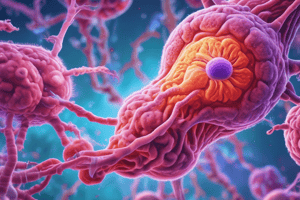Podcast
Questions and Answers
Which of the following is a bacteria that causes atypical pneumonia?
Which of the following is a bacteria that causes atypical pneumonia?
- Mycoplasma (correct)
- Streptococcus pneumoniae
- Legionella pneumophila
- Haemophilus influenzae
Which bacterium is considered an obligate intracellular parasite and does not make ATP?
Which bacterium is considered an obligate intracellular parasite and does not make ATP?
- Chlamydia pneumoniae (correct)
- Streptococcus pneumoniae
- Moraxella catarrhalis
- Haemophilus influenzae
What is the primary mode of transmission for Chlamydia pneumoniae?
What is the primary mode of transmission for Chlamydia pneumoniae?
- Sexual contact
- Blood transfusion
- Respiratory secretion (correct)
- Fecal-oral route
Which population is at higher risk for Chlamydia pneumoniae infection?
Which population is at higher risk for Chlamydia pneumoniae infection?
What is the characteristic X-ray finding associated with Chlamydia pneumoniae infection?
What is the characteristic X-ray finding associated with Chlamydia pneumoniae infection?
What is the most common presentation of Chlamydia pneumoniae infection?
What is the most common presentation of Chlamydia pneumoniae infection?
Which type of Chlamydia pneumoniae body is infectious?
Which type of Chlamydia pneumoniae body is infectious?
What is the main method for laboratory diagnostics of Chlamydia pneumoniae?
What is the main method for laboratory diagnostics of Chlamydia pneumoniae?
What is the primary mode of transmission for Chlamydia pneumoniae?
What is the primary mode of transmission for Chlamydia pneumoniae?
What is the effect of antibiotics on Chlamydia pneumoniae?
What is the effect of antibiotics on Chlamydia pneumoniae?
Which diagnostic method is specific and sensitive for Mycoplasma pneumoniae?
Which diagnostic method is specific and sensitive for Mycoplasma pneumoniae?
What type of pneumonia is commonly associated with Mycoplasma pneumoniae in young adults?
What type of pneumonia is commonly associated with Mycoplasma pneumoniae in young adults?
Which antibiotics are NOT recommended for use in children for treating Mycoplasma pneumoniae?
Which antibiotics are NOT recommended for use in children for treating Mycoplasma pneumoniae?
How does Mycoplasma pneumoniae transmit primarily?
How does Mycoplasma pneumoniae transmit primarily?
Which bacteria is responsible for causing atypical pneumonia (walking pneumonia)?
Which bacteria is responsible for causing atypical pneumonia (walking pneumonia)?
Which bacterium is known for causing Community Acquired Respiratory Distress Syndrome (CARDS) toxin?
Which bacterium is known for causing Community Acquired Respiratory Distress Syndrome (CARDS) toxin?
Which bacterium is characterized by having no peptidoglycan and using a tip-like organelle (P1 adhesin) to adhere to host epithelium?
Which bacterium is characterized by having no peptidoglycan and using a tip-like organelle (P1 adhesin) to adhere to host epithelium?
Which bacterium is responsible for causing necrotizing pneumonia and lung abscess?
Which bacterium is responsible for causing necrotizing pneumonia and lung abscess?
Which bacterium is associated with strict human pathogen causing community-acquired pneumonia in children (5-15 years old)?
Which bacterium is associated with strict human pathogen causing community-acquired pneumonia in children (5-15 years old)?
What is the primary mode of transmission for Mycoplasma pneumoniae?
What is the primary mode of transmission for Mycoplasma pneumoniae?
Flashcards are hidden until you start studying
Study Notes
Mycoplasma pneumoniae: Clinical Disease, Laboratory Diagnostics, and Treatments
- Mycoplasma pneumoniae primary presentation involves tracheobronchitis with slow onset and may develop low-grade fever, malaise, headache, and a dry, nonproductive cough without exudate.
- Atypical pneumonia, known as "walking pneumonia," is common in young adults and is characterized by patients generally feeling well, having a dry, nonproductive cough without exudate, and diffuse interstitial infiltrates on X-ray.
- Mycoplasma pneumoniae can cause various complications such as meningoencephalitis, paralysis, myelitis, pericarditis, hemolytic anemia, arthritis, mucocutaneous lesions, and may be involved in autoimmunity.
- Laboratory diagnostics for Mycoplasma pneumoniae include microscopy, which is not useful due to the organism's inability to stain, and culture on Eaton's agar, which requires prolonged incubation due to the colony's fried egg morphology.
- Serology with high titer or a four-fold rise in convalescence and polymerase chain reaction (PCR) on nasopharyngeal samples are specific and sensitive diagnostic methods for Mycoplasma pneumoniae.
- Treatment options for Mycoplasma pneumoniae include macrolides, tetracyclines (not for use in children), and fluoroquinolones (not for use in children), each with different mechanisms of action inhibiting bacterial growth.
- Mycoplasma pneumoniae is a strict aerobe, non-motile, and pleomorphic, and its cell membrane contains cholesterol without peptidoglycan or a cell wall.
- The transmission of Mycoplasma pneumoniae occurs through respiratory droplets, and it primarily causes community-acquired pneumonia in children aged 5-15 years.
- Mycoplasma pneumoniae possesses a tip-like organelle (P1) for tight adherence, cilia arrest, and cell death, as well as a purulent discharge and the ability to cause Community Acquired Respiratory Distress Syndrome (CARDS) toxin.
- Besides Mycoplasma pneumoniae, other Mycoplasma and Ureaplasma spp. can cause pneumonia and other diseases in different organ systems, with varying clinical presentations and laboratory diagnostics.
- Other causative agents of pneumonia include typical bacteria (e.g., Streptococcus pneumoniae) and atypical bacteria (e.g., Chlamydia pneumoniae, Legionella pneumophila) along with viral, hospital-acquired, and ventilator-associated pneumonia.
- Mycoplasma genitalium, M. hominis, and U. urealyticum colonize infants, particularly females, with varying persistence and prevalence rates, and require specific treatment based on their biochemical characteristics.
Pneumonia Causative Agents and Pathogens Overview
- The text provides information on the causative agents of pneumonia, including typical and atypical bacteria, viral, hospital-acquired, ventilator-associated, aspiration, zoonotic, chronic, and necrotizing pneumonia.
- It lists specific bacteria and viruses responsible for community-acquired pneumonia, hospital-acquired pneumonia, ventilator-associated pneumonia, aspiration pneumonia, and chronic pneumonia.
- The text also covers less common causes of viral pneumonia and provides a flow chart for identifying gram-negative bacteria and other pathogens related to pneumonia.
- It includes general biology, epidemiology, and pathogenesis of Mycoplasma pneumoniae, a common cause of atypical pneumonia.
- Mycoplasma pneumoniae's pathogenesis and virulence factors are discussed, including its adherence and colonization mechanisms, impact on respiratory epithelium, and the role of the CARDS toxin.
Studying That Suits You
Use AI to generate personalized quizzes and flashcards to suit your learning preferences.




